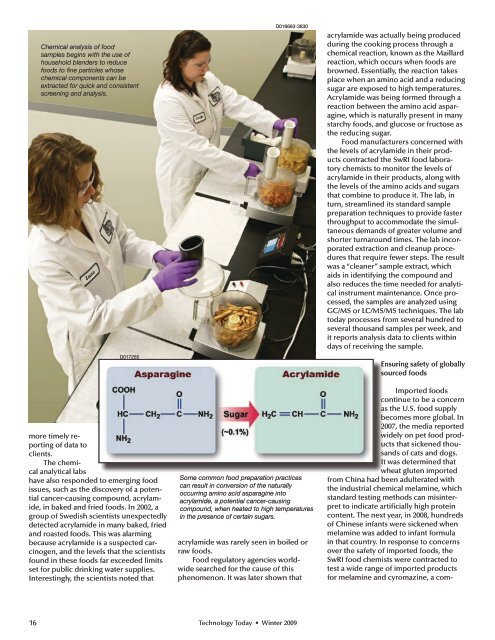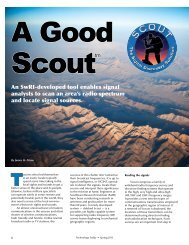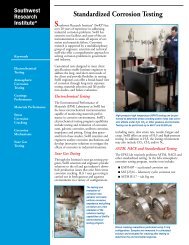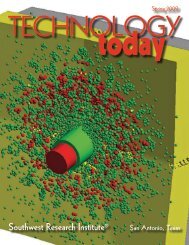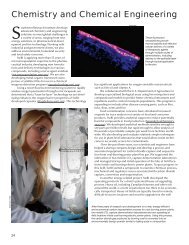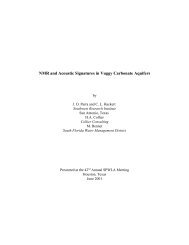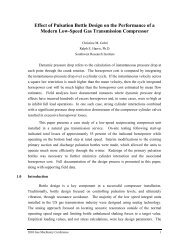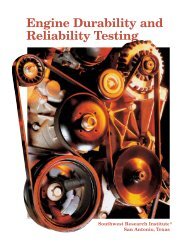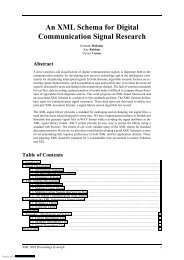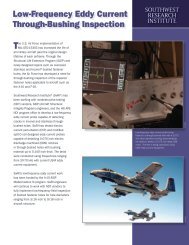Technology Today - Southwest Research Institute
Technology Today - Southwest Research Institute
Technology Today - Southwest Research Institute
Create successful ePaper yourself
Turn your PDF publications into a flip-book with our unique Google optimized e-Paper software.
Chemical analysis of food<br />
samples begins with the use of<br />
household blenders to reduce<br />
foods to fine particles whose<br />
chemical components can be<br />
extracted for quick and consistent<br />
screening and analysis.<br />
D017265<br />
more timely reporting<br />
of data to<br />
clients.<br />
The chemical<br />
analytical labs<br />
have also responded to emerging food<br />
issues, such as the discovery of a potential<br />
cancer-causing compound, acrylamide,<br />
in baked and fried foods. In 2002, a<br />
group of Swedish scientists unexpectedly<br />
detected acrylamide in many baked, fried<br />
and roasted foods. This was alarming<br />
because acrylamide is a suspected carcinogen,<br />
and the levels that the scientists<br />
found in these foods far exceeded limits<br />
set for public drinking water supplies.<br />
Interestingly, the scientists noted that<br />
D016683-3830<br />
Some common food preparation practices<br />
can result in conversion of the naturally<br />
occurring amino acid asparagine into<br />
acrylamide, a potential cancer-causing<br />
compound, when heated to high temperatures<br />
in the presence of certain sugars.<br />
acrylamide was rarely seen in boiled or<br />
raw foods.<br />
Food regulatory agencies worldwide<br />
searched for the cause of this<br />
phenomenon. It was later shown that<br />
acrylamide was actually being produced<br />
during the cooking process through a<br />
chemical reaction, known as the Maillard<br />
reaction, which occurs when foods are<br />
browned. Essentially, the reaction takes<br />
place when an amino acid and a reducing<br />
sugar are exposed to high temperatures.<br />
Acrylamide was being formed through a<br />
reaction between the amino acid asparagine,<br />
which is naturally present in many<br />
starchy foods, and glucose or fructose as<br />
the reducing sugar.<br />
Food manufacturers concerned with<br />
the levels of acrylamide in their products<br />
contracted the SwRI food laboratory<br />
chemists to monitor the levels of<br />
acrylamide in their products, along with<br />
the levels of the amino acids and sugars<br />
that combine to produce it. The lab, in<br />
turn, streamlined its standard sample<br />
preparation techniques to provide faster<br />
throughput to accommodate the simultaneous<br />
demands of greater volume and<br />
shorter turnaround times. The lab incorporated<br />
extraction and cleanup procedures<br />
that require fewer steps. The result<br />
was a “cleaner” sample extract, which<br />
aids in identifying the compound and<br />
also reduces the time needed for analytical<br />
instrument maintenance. Once processed,<br />
the samples are analyzed using<br />
GC/MS or LC/MS/MS techniques. The lab<br />
today processes from several hundred to<br />
several thousand samples per week, and<br />
it reports analysis data to clients within<br />
days of receiving the sample.<br />
Ensuring safety of globally<br />
sourced foods<br />
Imported foods<br />
continue to be a concern<br />
as the U.S. food supply<br />
becomes more global. In<br />
2007, the media reported<br />
widely on pet food products<br />
that sickened thousands<br />
of cats and dogs.<br />
It was determined that<br />
wheat gluten imported<br />
from China had been adulterated with<br />
the industrial chemical melamine, which<br />
standard testing methods can misinterpret<br />
to indicate artificially high protein<br />
content. The next year, in 2008, hundreds<br />
of Chinese infants were sickened when<br />
melamine was added to infant formula<br />
in that country. In response to concerns<br />
over the safety of imported foods, the<br />
SwRI food chemists were contracted to<br />
test a wide range of imported products<br />
for melamine and cyromazine, a com-<br />
16<br />
<strong>Technology</strong> <strong>Today</strong> • Winter 2009


